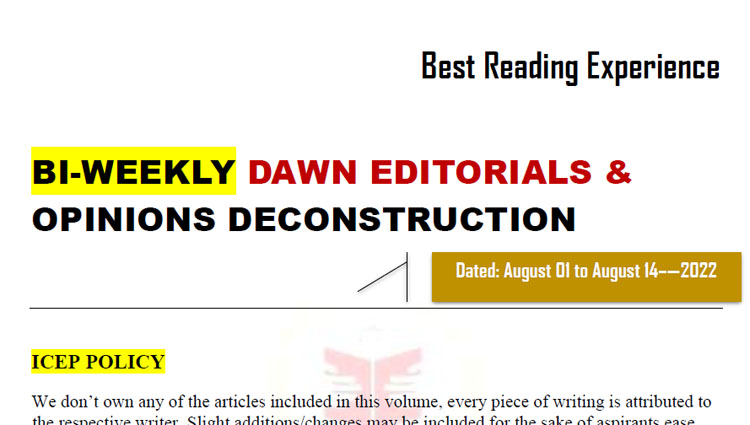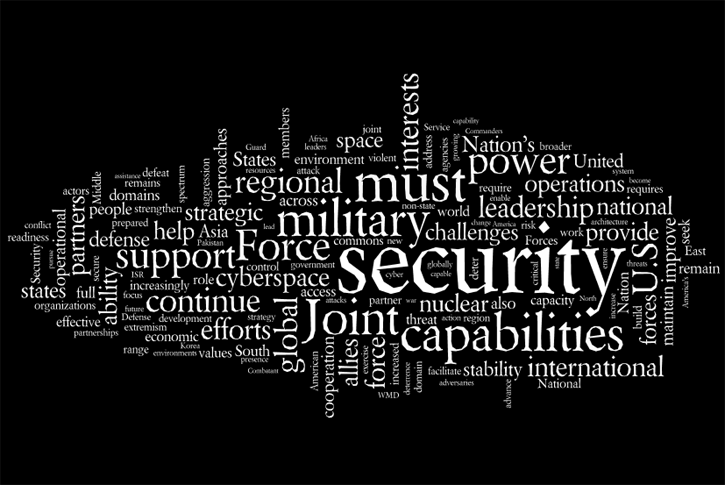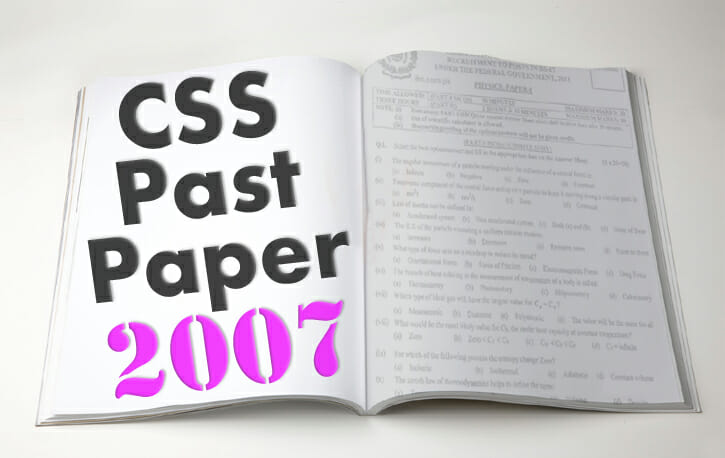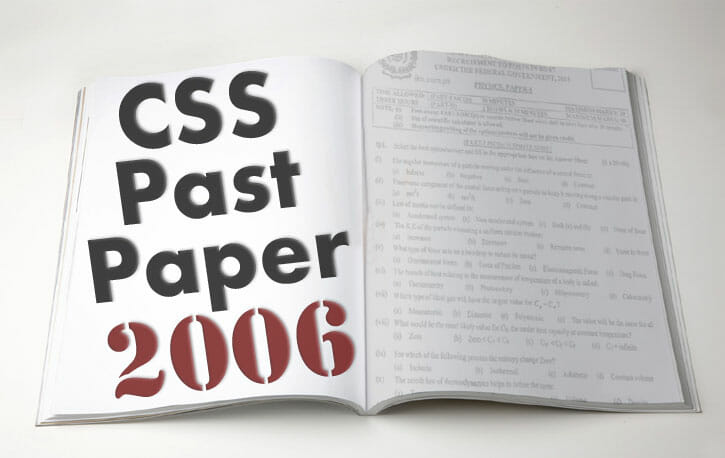We don’t own any of the articles included in this volume, every piece of writing is attributed to the respective writer. Slight additions/changes may be included for the sake of aspirants ease.


We don’t own any of the articles included in this volume, every piece of writing is attributed to the respective writer. Slight additions/changes may be included for the sake of aspirants ease.

Beside ideology which factors were responsible for the creation of Pakistan? (CSS 1988, 1990)
Causes of Muslim separatism. (CSS 1991, 1996)
Ideological foundations of “Two-Nations Theory“. (CSS 2002, 2003)
Elucidate Ideology of Pakistan. What are the reasons which contributed for the development of two-nation-theory? Is two-nation-theory relevant after the fall of Dacca? (CSS 2007)
Muslims Nationalism in subcontinent evolved gradually. (CSS 1988)

By: Iftikhar Ahmad
A general sense of dissatisfaction about credibility of accountability and performance of government is nothing new. Students of public administration and public policy and experts from allied fields of study such as sociology, political science and economics have been engaged in structural functional analysis with a view to improving the system of government that impacts the life of citizens. Microeconomic goals suggest as to how to improve the functioning of the state itself by emphasizing anti-corruption measures. The problem in this context is that international institutions such as IMF and world Bank may get an incorrect perspective that fails to recognize the role of political institutions and the constraints they place on policymaking. Adopting better policies and institutions are not successful because they do not take place in the context of an explanation of why bad policies and institutions are there in the first place. Also, there are problems of non-implementation which render all efforts at policymaking futile. It suggests the need to define the relationship of administrative functions to the Legislative, executive, and judicial branches of government, and also to have an idea of comparative perspective of administration and administrative organizations.
For illustrative purposes, it is helpful to liken the flow of authority in governmental administration to that in private corporations. In such an analogy, the legislature roughly corresponds to a “board of directors” which determines over-all activities and policies. The executive roughly corresponds to a “general manager” who, with the approval of the directors, supplies immediate leadership, directs activities, and assumes responsibility for making important staff appointments. Members of governmental administration correspond to the rank and file of department heads and subordinates who perform specified tasks as responsibly as possible within their limited spheres and give impartial treatment to the public. At all times, administrators are liable to censure by the legislature, to discipline by the executive, to over rulings by the courts, and to criticisms from the public-which range from general charges of “bureaucracy” to complaints about inefficiency in the performance of particular tasks. Administrators may sometimes initiate policies that are adopted by their superiors, but they usually conduct their work efficiently without expecting more than a small measure of recognition; sometimes no recognition at all has been forthcoming.

By: Yasser Latif Hamdani
While the powers that be and politicians fight for the control of the state, there are festering wounds in our body politic that remain unaddressed. Real issues are persistently ignored and swept under the carpet with devastating results.
On October 25, 2019 yet another Ahmadi “place of worship” was desecrated by the state in Bahawalpur. Countless individuals remain behind bars on blasphemy charges including the young professor Junaid Hafeez. Countless young women from minority communities will continue to converted forcibly to Islam in Sindh. The Federal Capital will see yet another Dharna where inevitably religion will be misused. Fundamental rights such as freedom of religion and freedom of expression will continue be trampled for political expediency and freedom of press will continue to be denied. Meanwhile the economy continues to nosedive. By February 2020, we may even be on the FATF blacklist. Our brightest minds continue to flee the country. Such is the state of affairs in Pakistan in the closing months of 2019.

Addressing a seminar on ‘Interplay of Economy and Security” in Karachi last week, COAS General Qamar Javed Bajwa underlined the need to ensure a viable balance between economy and security in order to achieve prosperity. He pointed out that “national security and economy are interlinked in today’s world”. He expressed concerns over the country’s ‘sky high debt’ as well as the ‘abysmally low’ tax-to- GDP ratio. He also called for increasing tax base, bringing fiscal discipline and ensuring continuity of economic policies in Pakistan. Later, talking to the host of a popular TV talk show, DG ISPR said, “If Pakistan’s economy is not good, security is not good either”. Interior Minister Ahsan Iqbal, being highly concerned about the civilian supremacy, advised DG ISPR to refrain from commenting on the economy in public. In fact, this recent ‘national security-economy linkage’ saga just indicates that there is considerable trust-deficit between the military establishment and the civil government in Pakistan. At the same time, it also shows the fact of expanding domain of national security in the country.

Time Allowed: 3 Hours Maximum Marks: 100
Note: (i) Attempt ONLY FIVE questions in all, including QUESTION NO. 1, which is COMPULSORY. All questions carry EQUAL marks.
(ii) Extra attempt of any question or any part of the attempted question will not be considered.
(iii) Candidate must draw two straight lines (======) at the end to separate each question attempted in Answer Books.
Q.1. Write only the correct answer in the Answer Book. Do not reproduce the question.
(1) The first Muslim general entered Victorious in the sub-continent Indo-Pak in the year:
(a) 612 AD (b) 712 AD
(c) 812 AD (d) None of these
(2) On the execution of Muhammad Bin Qasim, the rule of Caliph ended and Arab princes in Mansura (Sindh) and Multan (Punjab) established their independent dynasties in Sub-continent in the year:
(a) 861 AD (b) 871 AD
(c) 881 AD (d) None of these
(3) Who became the first Sultan of newly established Muslim Sultanate of Delhi in 1207:
(a) Shahabudin Ghuri (b) Qatub-din Aibek
(c) Zaheer-ud-din Babar (d) None of these
(4) Who has written the book entitled “The Making of Pakistan?”
(a) Qurashi I. H. (b) Muhammad Ali Ch.
(c) Waheed-uz-Zaman (d) None of these
(5) Who was first appointed Nazim of Nadva-ul-Ulema in 1883?
(a) Maulana Shibli
(b) Maulvi Abdul Ghafoor
(c) Maulana Syed Muhammad Ali
(d) None of these
(6) Pakistan’s ideology is based on the ideals of:
(a) Democracy (b) Theocracy
(c) Islam (d) None of these
(7) Quaid-e-Azam called Islam “Our bedrock and sheet anchor” while addressing:
(a) Punjab Students Federation
(b) Muslim Students Peshawar
(c) Indian Muslims
(d) None of these
(8) The resolution for formation of All-Indian Muslim League was passed at the meeting of All India Education Conference (1906) and was moved by:
(a) Nawab Viqar ul Mulk (b) Nawab Mohsin ul Mulk
(c) Nawab Salim ullah (d) None of these
(9) The demand of separate electorate for Indian Muslims was first accepted in the Act of:
(a) 1909 (b) 1919
(c) 1935 (d) None of these
(10) The provincial governments of Congress resigned and All-India Muslim League as a mark of relief observed the “Day of Deliverance” on:
(a) 22 Oct. 1939 (b) 22 Nov. 1939
(c) 22 Dec. 1939 (d) None of these
(11) The Lahore Resolution was amended and Pakistan was made part of League’s objective. The amendment was made in the Annual session (1941) of All India Muslim League, which was held at:
(a) Karachi (b) Lahore
(c) Madras (d) None of these
(12) Radcliff Commission submitted its formula for the division of India in to two countries to Lord Mountbatten on:
(a) 9 August 1947 (b) 19 August 1947
(c) 29 August 1947 (d) None of these
(13) Ch. Rahmat Ali, the architect of the name of the Pakistan, died on:
(a) Feb. 2, 1951 (b) Feb. 12, 1951
(c) Feb. 22, 1951 (d) None of these
(14) Liaquat Ali Khan, the first Prime Minister of Pakistan, while addressing a meeting at Rawalpindi was assassinated on:
(a) Oct 6, 1951 (b) Oct. 16, 1951
(c) Oct. 26, 1951 (d) None of these
(15) The Legal Framework Order, which amended a constitution of Pakistan unilaterally was issued by:
(a) Yahya Khan (b) Ayub Khan
(c) Zia-ul-Haq (d) None of these
(16) The country, which supported the Pakistan Movement before the emergence of Pakistan:
(a) Iran (b) Indonesia
(c) Saudi Arabia (d) None of these
(17) Durand Line, which divided the border of Pakistan and Afghanistan, is as long as:
(a) 2252 Km (b) 2262 Km
(c) 2272 Km (d) None of these
(18) Which mountain range is located between China and Pakistan?
(a) Siwaliks (b) Hindukush Range
(c) Great Himalayas (d) None of these
(19) What is the total area of Pakistan (in square kilometer)?
(a) 695095 (b) 795095
(c) 796096 (d) None of these
(20) The Regional Cooperation for Development (RCD) was established among Pakistan, Iran and Turkey in 1964 and was annulled in:
(a) 1969 (b) 1979
(c) 1989 (d) None of these
Q.2. Critically evaluate the contribution made by missionaries in the growth of Muslim society in the Sub-continent of Indo-Pak.
Q.3. The Deoband School stood for “definite religio-political goals with limited sphere of influence.” Discuss.
Q.4. Elucidate Ideology of Pakistan. What are the reasons which contributed for the development of two-nation theory? Is two-nation theory relevant after the fall of Dacca? Discuss
Q.5. Minto – Morely Reforms was a “tool of change” in the political system of India. Discuss it with special reference to the demands of Simla Deputation.
Q.6. Local government system under the “Devolution of Power Plan 2001” has miserably failed in delivering services to the masses. Discuss.
Q.7. “Pakistan is a federation in form and unitary in spirit.” Discuss it keeping in view the strengths and weaknesses of Federation of Pakistan.
Q.8. Highlight the salient features of National Education Policy of 1998-99. How can we improve the education standard of people of Pakistan?

Time Allowed: 3 Hours Maximum Marks: 100
Note: (i) Attempt ONLY FIVE questions in all, including QUESTION NO.1, which is COMPULSORY.
(ii) Extra attempt of any question or any part of the attempted question will not be considered.
(iii) All questions carry EQUAL marks.
1. Write only the correct answer in the Answer Book. Do not reproduce the question.